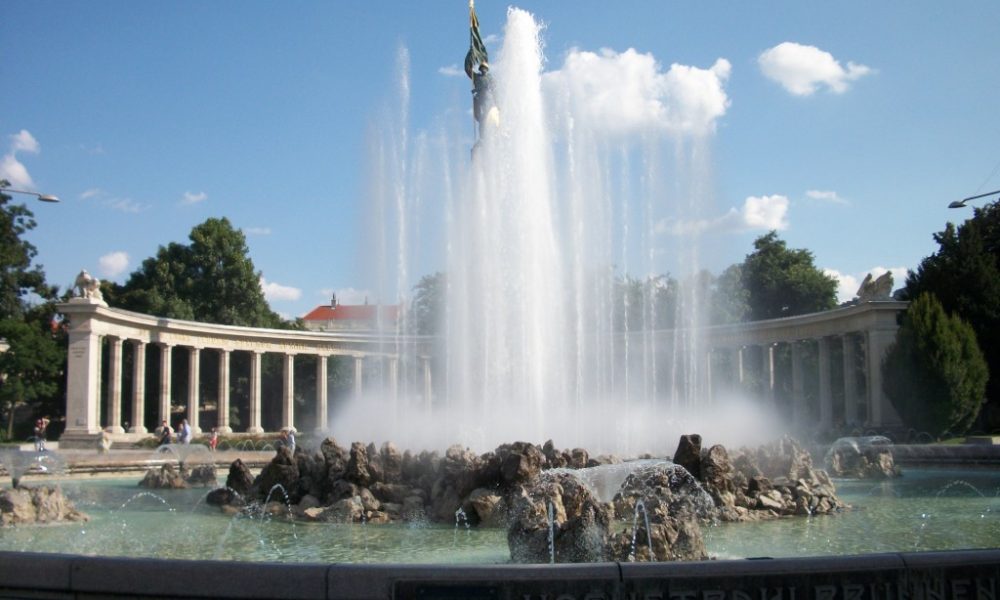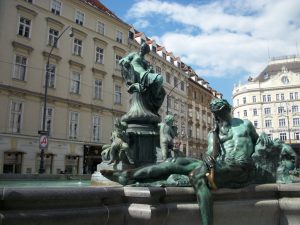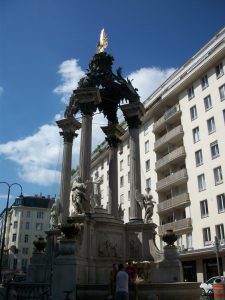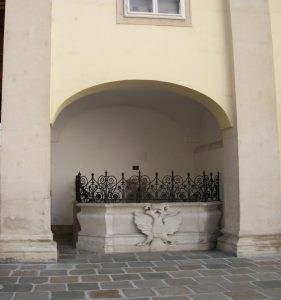Vienna’s Fountains

Cool meeting places in the heat of the city
During summer, it can get really hot in the city of Vienna. When the thermometers are over 30°C, the air appears to flicker, there’s no breeze, and people are longing to cool off…. What do you hear over there? A quiet burbling sound perhaps? Or are they merely hallucinations? You can confidently follow the sound, since it surely one of the many fountains in Vienna. In the summer, these fountains – like oases in the desert – serve as recreational “cool spots” in the city. At the same time, they’re popular meeting places that really stand out among the Viennese as well as visitors and guests to the city, before diving into all the hustle and bustle of the city.
Vienna’s fountains – back then…
Already during Roman times, the public fountains supplied the population with water as well as firefighting, which was unfortunately often necessary. Over time, the fountains turned into representative monuments, which were intricately built and artistically designed.
During the late Middle Ages, the fountains were available primarily to markets on the corresponding public squares in Vienna. In 1310, a water pipeline under the Tuchlauben was first mentioned. Starting in the 16th century, the first monument fountains came about, which had representative purposes in addition to their function as water dispensers.
Vienna’s water supply was continually improved thanks to the construction of the water pipelines. The public fountains thus gradually lost their significance over time. At the same time, domestic wells, of which there were around 10,000 in the mid-19th century, also disappeared (recommended reading: Der Basilisk in der Schönlaterngasse (available only in Germen), an old Viennese legend about a basilisk that was said to have lived in a domestic well in the year 1212).
… and today: water fountains, monument and memorial fountains
There are now more than 900 water fountains in Vienna, as well as 54 monument and memorial fountains that are managed by the city of Vienna. The water fountains that are overseen by Wiener Wasser and the Stadtgärten are available as a free opportunity for refreshment to anyone who happens to be thirsty. The city of Vienna has created a mobile city map in which all of the city’s water fountains are visible.
The monument and memorial fountains come across as much more conspicuous. They often came about from special occasions and were usually created by famous artists of their era. I’ll go into more detail for a couple of these special fountains, without wishing to make the many others seem any less significant – every one of them has its own history (which you can read in volumes 1 and 2 of Auf springt der Quell – Wasser im Stadtbild – Ein Wiener Brunnenlexikon by Josef Donner, Österreichische Vereinigung für Gas- und Wasserfach ÖVGW, Vienna).
The Donnerbrunnen
at Neuer Markt, Vienna’s 1st District
The Donnerbrunnen is actually named “Providentiabrunnen.” The Viennese couldn’t do much with the term providentia (Latin for “destiny”) and named the fountain instead after its constructor, Georg Raphael Donner, who designed the fountain between 1737 and 1739. People sometimes also speak of the “Mehlmarktbrunnen,” since the Neuer Markt (“new market”) was called the “Mehlmarkt” (“flour market”) in the 18th century.
The fountain’s central figure is Providentia as an allegory of destiny and foresight. She is surrounded by four figures, which represent the rivers of Traun, Enns, Ybbs and March in the archduchy of Austria; they simultaneously represent the four ages and temperaments. On the base can be found four putti with water-spitting fish (pike, carp, catfish and salmon), which are the fountain’s true water dispensers and symbolize the Danube.
The Vermählungsbrunnen
at Hoher Markt, Vienna’s 1st District
The Vermählungsbrunnen got its name from the representation of the so-called bridal group of Mary and Joseph with the high priest. The Vermählungsbrunnen is also called the “Josefsbrunnen.”
The “Josephssäule” (Joseph’s column) was originally constructed on the square that is now the location of the Vermählungsbrunnen. This votive monument hearkens back to a vow by Emperor Leopold I in 1702, who, concerned about the return of his son Joseph from the siege of the Palatine Landau Fortress (in the War of the Spanish Succession), vowed to construct a memorial. This promise was honored by his sons after 1705. Under Joseph I, a wooden monument was made according to a draft by the court architect Johann Bernhard Fischer von Erlach and was mounted at Hoher Markt on March 19, 1706.
As the wooden votive monument was very bleak, Emperor Charles VI had a Baroque temple built in 1725 according to a drawing by Joseph Emanuel Fischer von Erlach. On three sides of the base can be seen reliefs – the adoration of the shepherds, the adoration of the kings and the representation in the temple. On the fourth side is an inscription. On the base itself (like on the votive monument) are statues of Mary, Joseph and the high priest. Four statues of angels sit on the pedestal ledges, carried by four Corinthian columns, covered by a bronze baldachin. The basin of the fountain (built in 1728) consists of Kaiserstein (“Emperor’s stone”) and marble from the Unterberg region of Austria.
The Schweizerhofbrunnen
in the Swiss tract of Vienna’s Hofburg Palace, Vienna’s 1st District
The oldest extant fountain in Vienna, the Schweizerhofbrunnen, was constructed by the sculptor Pietro Solari in 1552 in a side niche of the Schweizertor (Swiss Gate). On the basin of the fountain, one can recognize a relief of the imperial two-headed eagle of Charles V, and the water outlet is shaped like a dragon’s head. The basin is made of white Kaiserstein from Kaisersteinbruch (a municipality in Lower Austria). The fountain forms the end of a water pipeline that had been laid way back in 1534, which was routed from the suburbs into the palace.
The Hochstrahlbrunnen
at Schwarzenbergplatz, Vienna’s 3rd District (see head/cover picture)
The Hochstrahlbrunnen at Schwarzenbergplatz was put into operation on October 24, 1873 by Emperor Franz Joseph on the occasion of the completion of Vienna’s first mountain spring water pipe. The developer Gustav Bruck was responsible for the construction of the fountain. On June 23, 1906, the Hochstrahlbrunnen was reopened in the style of a fontaine lumineuse by the architect Oskar Marmorek (1863–1909), and thus as a lighted fountain at night.
At the basin’s edge are 365 little waterspout fountains – these symbolize the days of the year. The six waterspout fountains between the basin’s edge and inner islands, as well as the islands themselves, represent the seven days of the week. Twelve high rays correspond to the 12 months, 24 low rays represent the 24 hours of the day, and the 30 rays in the island represent the 30 days of the month. At night, the fountain customarily glows red, pink, yellow, purple, blue and green.
Whichever of the city’s fountains you happen to pass – if you can, take a bit of time, listen to the calming burble of the water, dip your hand into the cool water and enjoy the ever more necessary feeling of slowing down in today’s hectic times.
Data sources: © Wien.gv.at; Wikipedia.













